![]() March - April 2003
March - April 2003
Celebrating 90 Years of Service
By Jon C. Halter
Photograph By John R. Fulton Jr.
Since April 1913, Scouting magazine has delivered information, instruction, and inspiration to the registered volunteer leaders of the Boy Scouts of America.
- First Issue: April 15, 1913 [PDF file]
- Some items taken from the pages of 85 years of Scouting magazine.
- Scouting Magazine Comes of Age: An Editor Remembers
- The 85 Year Trail of Scouting Magazine
- 75 Years in the Life of a Magazine
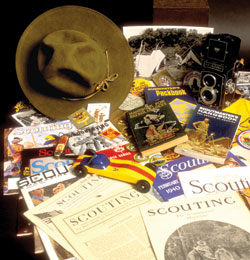
In April 1913, Scoutmasters and other Scouting "registered officials" across the United States received their first copy of Scouting, a new publication sent directly from the headquarters of the Boy Scouts of America in New York City.
The editors of the semimonthly bulletin outlined its "purpose and scope" on page one of the eight-page publication. The need for a national publication for Scout leaders was obvious. Three years after the BSA's founding in February 1910, it had become too costly for national headquarters to continue informing the growing number of registered leaders about developments by sending special bulletins and "circular letters."
There was much news and information to communicate.
"National Headquarters is daily in receipt of reports of incidents illustrating the practical value of the Scout Movement," Scouting's editors reported. "These, when distributed promptly, will serve to inspire similar activity among other Scout Masters."
The new publication also would keep volunteers informed of developments in the different departments within BSA national headquarters, and report on how other leaders "are encountering unusual problems" or "have successfully handled difficult situations."
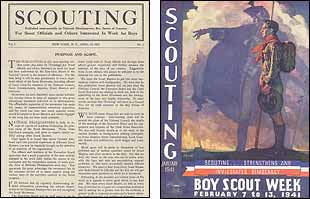 April 1913 (left) and January 1941 (right) |
And Scouting would always offer leaders a sympathetic ear in their search for solutions. "...for every Scout Master who finds himself in difficulty," the editors declared, "we will get discussion upon questions in which he is interested."
Finally, the publication promised "fellowship in the broadest and noblest sense of the word as it appeals to every good Scout...We want every Scout Master, as well as every boy, to feel that he is a part of a tremendous institution that is making for a greater love for the outdoors, a greater pride in muscular prowess and a keener stimulus toward strength and nobility of character."
A surprisingly small number of letters have [sic] been received commenting on the merit badge problem which was opened for general discussion in the issue of Scouting for November 15.It is difficult for the National officials to act intelligently on these problems without having a full expression of opinion on the part of the men who are actually putting the principles of Scouting into effect in their work with their troops. If you have any suggestions—either adverse or favorable—on the present merit badge system, let us have the benefit of your experience.
— Scouting, Dec. 1, 1915
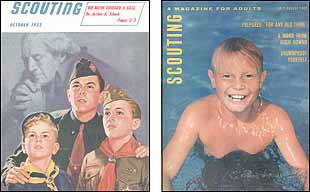 October 1955 (left) and July 1962 (right) |
A reader looking through past issues of Scouting from its inception will note that the fundamental purposes and experiences of the Scouting program remain basically the same as when the movement was born in the first decade of the 20th century. At the same time, changes have occurred constantly and been duly reported in the pages of Scouting.
For example, the first issue included a report on the progress of Sea Scouting, the proposed "sea or water branch of Scouting." Another news item reported on the future publication of the first and much-needed handbook for Scoutmasters.
An editorial urged every troop leader "to have his boys spend at least a week or 10 days in camp during the summer." And troops were encouraged to submit reports and photographs of activities to Boys' Life, the magazine for young readers the BSA had been publishing since 1911.
A news item reported how Scouts from Allegheny County, Pa., had helped flood victims by contributing $200 of their own money and collecting 300 items of clothing. Nearly 90 years later, the magazine would report how members of BSA Troop 12 at Ramstein Air Force Base in Germany were to bag groceries at the commissary to raise camping funds; instead, the Scouts gave their earnings to relief efforts for the Sept. 11, 2001, tragedy.
And the National Court of Honor reported that 1,692 merit badges earned in the first three months of 1913 were almost as many as the 1,906 merit badges earned during the BSA's first three years. Also awarded in early 1913 were 15 Eagle Scout badges, and four bronze and two silver medals to Scouts who saved lives.
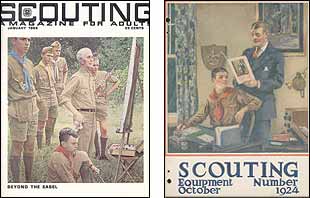 January 1969 (left) and October 1924 (right) |
In fact, aside from the unusual spelling of "Scout Master," not much in the first issue of Scouting would seem unusual to a Scout leader of today or any other era.
In all the reports which have been received at National Headquarters since the adoption of the slogan, "Every Scout to Feed a Soldier," there is none as yet from a troop which has not started a garden. In a great majority of cases, there are individual as well as troop gardens.— Scouting, Sept. 1, 1917
After the United States entered World War I in 1917, much of the content of Scouting focused on how Scouts were supporting the war effort, including national Good Turns to increase food production and sell Liberty Bonds.
One of the most enthusiastic supporters of Scouting during the BSA's first decade was Theodore Roosevelt. The Sept. 15, 1917, issue of Scouting told how the former president of the United States had attended an encampment of 1,200 Scouts at Mineola, N.Y.
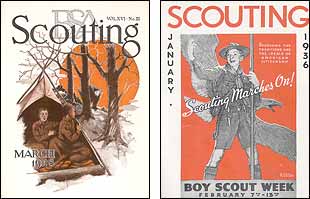 March 1928 (left) and January 1936 (right) |
Retired from public office, Roosevelt continued to be active in Scouting as honorary commissioner of Nassau County, N.Y., and as a committee member for the troop at Christ Episcopal Church in Oyster Bay, N.Y. "We have got 258,000 Boy Scouts of America and about 75,000 people who are in the movement as leaders," TR told the assembled campers, "and I won't be content until instead of 258,000 we have 2,580,000."
We think every boy should be in the uniform, but some of them get careless. So in our patrol point system each boy is given five points for being present on time...and two points extra if he is in uniform. We find that this encourages the boys to wear the uniform, be on time, and so forth....Paul Hodson, Scoutmaster, Troop 3
East St. Louis, Ill.
— Scouting, March 1925
The BSA would not reach the youth membership levels that Teddy Roosevelt had hoped for until the 1950's. However, membership increased steadily and by early 1925 there were more than half a million Boy Scouts in 22,485 troops, with 156,000 registered adult leaders.
An eight-page issue of Scouting was published each month, except for a jumbo 50-page "equipment number" (actually a catalog for the BSA National Supply Department) in May and October.
By the 1920's, each issue of Scouting included, as a resource for unit leaders, a one-month outline of weekly troop meetings and a scheduled outing or hike. An additional section was titled "What a Scoutmaster Can Do [next month]."
Leaders enthusiastically welcomed the meeting plans. A California Scoutmaster even urged the editors to mail each issue two weeks earlier than normal, to allow more time to implement the program ideas for the coming month.
...The only way to eliminate initiations from the program of Scouting...is for all Scouters to unite not only in abolishing all troop initiations but in forestalling all tendencies in that direction by bringing home clearly to Scouts that initiations cannot possibly be reconciled with the Scout Oath and Law, which they of their own free will have promised on their honor to keep....Robert G. Smith, Assistant Scoutmaster, Troop 130
Philadelphia Council
— Scouting, February 1936
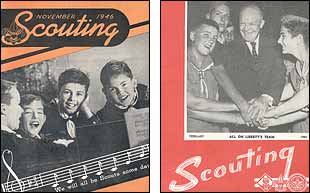 November 1946 (left) and February 1953 (right) |
Jump ahead another decade. By the mid 1930's Scouting was a full-fledged 36-page monthly magazine with a colorful cover. It featured longer articles and fewer of the shorter news items that had filled its pages in its early years.
Cub Scouting had been added to the BSA program in 1930, so the magazine now billed itself as "A magazine of information for All Scouters." In each issue, "Troop Program Suggestions" provided Boy Scout leaders with monthly meeting plans and themes, although Cub Scout leaders had to look elsewhere for help.
In January 1936, more than 200,000 registered Scouters were receiving the magazine.
With the World Friendship Fund scarcely six months old, and with many units just beginning to realize how they may help to reestablish Scouting in war devastated countries, some help has already been sent abroad...but there is a vast amount of work yet to be done. It is hoped that packs, troops, and senior units will continue to contribute to the World Friendship Fund.— Scouting, September 1945
Following the nation's entry into World War II in December 1941, Scouting magazine, then being published monthly except August, covered in detail the various ways Scouts were supporting the war effort, including doing national Good Turns to collect scrap metal, maintaining "Victory Gardens," and helping to sell war bonds. Monthly "Troop Program Source Material" in each issue helped Scoutmasters plan meetings.
When the war ended in 1945, Scouting reported that more than 420,000 registered volunteer leaders were receiving the magazine, now published 10 times a year.
The decade of the 1940's ended with Scouting placing feature articles into sections for Cub Scout leaders, Boy Scout leaders, and leaders of Exploring, the BSA's newest program for older boys.
More than a million merit badges—1,041,008 to be exact—were awarded in 1954. This breaks all records and brings the total of merit badges passed since they were instituted in 1911 to nearly twenty million.Maybe it's the do-it-yourself trend that's responsible, but the Home Repairs merit badge led in popularity with 66,430, followed by Cooking with 58,204. In third place was First Aid, 55,891.
— Scouting, November 1955
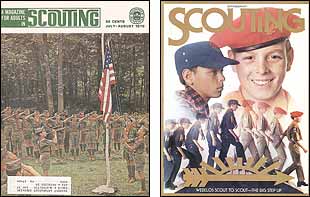 July 1970 (left) and September 1977 (right) |
The 1950's saw BSA membership swelled by the influx of the postwar baby boom generation. A special three-year growth emphasis between 1952 and 1955 helped membership jump 49 percent, from just under 2.8 million to more than 4.1 million. In 1958 Scouting reported that 1,340,000 men and women were volunteer leaders in the BSA.
By the end of the decade registered Scouters were receiving the magazine nine times a year. Firmly established as editorial features were sections that would still be present in the first years of the 21st century: Front Line Stuff, where readers sent in solutions to specific problems submitted by individual Scouters; and Worth Retelling, where readers shared humorous and inspirational anecdotes.
The Ed Sullivan Show on Sunday, February 7, will feature a Cub Scout, Boy Scout, and Explorer in observance of Boy Scout Week. Ed will salute the 51/2 million members of the BSA on its 55th birthday. The boys will lead hundreds of thousand of Scouts and leaders in a rededication ceremony on CBS network TV.— Scouting, February 1965
In 1963, Scouting magazine celebrated its 50th anniversary. Longtime editor Lex R. Lucas noted that the magazine was launched in 1913 "to serve as a council fire for all adult members of the Boy Scouts of America." Five decades later, it was "still burning (we hope blazing) in the homes of 1,412,632 Scouters."
In October 1965 Lucas wrote his 223rd and final "Personally Speaking" column, ending a tradition he began as managing editor in July 1943.
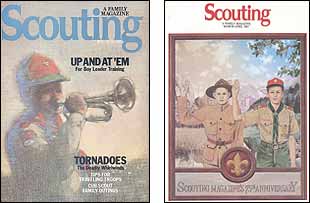 May 1981 (left) and March 1987 (right) |
In his farewell column, the veteran of 54 years in Scouting as a youth and adult paid tribute to the magazine's readership of volunteer leaders. "You are absolutely and vitally necessary to Scouting's success, and because of you it is succeeding," he wrote. "...I feel wonderfully fortunate to have had the chance to work with folks like you."
The December 1969 issue alerted readers to look for a redesigned Scouting magazine in 1970 with "sharper articles aimed at relevant needs of Scouters whose target is the needs of a representative third of all boys." (The changes would include a reduction from 10 issues to the six-a-year schedule still followed today.)
This issue of our magazine is the largest in its 59-year history, and the reasons for its sheer bulk are impressive: our Scouting movement is advancing on dozens of fronts, and we want you Scouters in on the action all the way....Walt Babson, Editor
— Scouting, September 1972
For five issues in 1970 the redesigned cover proclaimed the title to be "A Magazine for Adults in SCOUTING." Despite the new look and title, the editors promised to carry on the tradition of serving as "a clearinghouse for ideas, instruction, and inspiration."
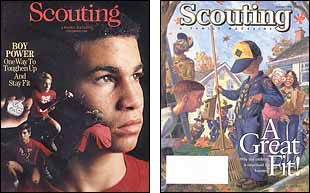 September 1989 (left) and October 1998 (right) |
The November-December 1970 issue, however, sported yet another redesign, and the simple title Scouting. That issue marked the first as editor for the late Walter Babson, who would guide the magazine for the next 19 years in a steady improvement in graphics, writing style, article variety, and creativity in covering the BSA's increasingly diverse programs.
The BSA's continued and expanded efforts to reach more youth have both increased the subjects covered in Scouting and also changed the nature of the magazine's readership.
In 1913, Scouting was sent to registered volunteer leaders who were mostly male and involved in a Boy Scout program for boys age 12 to 18.
Today, the magazine's readership includes leaders of three distinct programs whose leadership concerns range from 7-year-old (male) Tiger Cubs through 20-year-old (male and female) Venturers.
However, like Lex Lucas, Walter Babson, and the other editors who have preceded us, the staff of today's magazine welcomes the continuing challenge of informing, instructing, and inspiring our readers.
That's because you—the 1 million or so registered volunteer leaders who make up the vast majority of our readership—are also the source of most of our articles. And we are honored—and inspired—to share your success stories with your fellow leaders and families.
Without your efforts, the Boy Scouts of America could never succeed in its mission of providing character development and leadership training to America's youth.
And Scouting magazine will continue to serve as a key resource for men and women like you who tirelessly donate your time and effort to that goal.
Jon C. Halter has been the editor of Scouting magazine since November 1994.
To Learn More About Scouting MagazineThe Scouting magazine Web site, www.scoutingmagazine.org, contains features from two previous anniversary issues. Click here to see "75 Years in the Life of a Magazine" (from March-April 1987), by Keith Monroe, which describes the contributions of the magazine's various editors and staff members, as well as the influence of the first Chief Scout Executive, James E. West. "The 85-Year Trail of Scouting Magazine" (from March-April 1998), by contributing editor Robert Peterson, which focuses on the magazine's evolving content, appearance, and function. "Scouting Magazine Comes of Age" (from March-April 1998), in which editor emeritus Ernest Doclar recalls how major changes occurred in the magazine during the decades following World War II. Also scheduled to be available for downloading from the Web site is a pdf file of the eight-page first issue of Scouting, Vol. 1, No. 1, dated April 15, 1913. |
March-April 2003 Table of Contents
Copyright © 2003 by the Boy Scouts of America. All rights thereunder reserved; anything appearing in Scouting magazine or on its Web site may not be reprinted either wholly or in part without written permission. Because of freedom given authors, opinions may not reflect official concurrence.
| The Boy Scouts of America | http://www.Scouting.org |